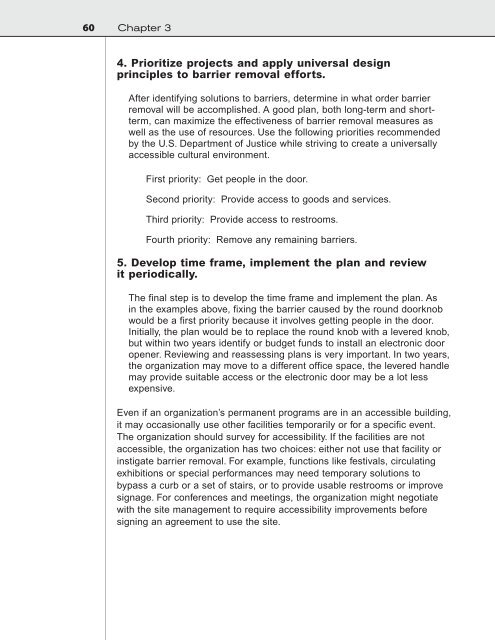Design for Accessibility: A Cultural Administrator's Handbook
Design for Accessibility: A Cultural Administrator's Handbook
Design for Accessibility: A Cultural Administrator's Handbook
You also want an ePaper? Increase the reach of your titles
YUMPU automatically turns print PDFs into web optimized ePapers that Google loves.
60 Chapter 3<br />
4. Prioritize projects and apply universal design<br />
principles to barrier removal ef<strong>for</strong>ts.<br />
After identifying solutions to barriers, determine in what order barrier<br />
removal will be accomplished. A good plan, both long-term and shortterm,<br />
can maximize the effectiveness of barrier removal measures as<br />
well as the use of resources. Use the following priorities recommended<br />
by the U.S. Department of Justice while striving to create a universally<br />
accessible cultural environment.<br />
First priority: Get people in the door.<br />
Second priority: Provide access to goods and services.<br />
Third priority: Provide access to restrooms.<br />
Fourth priority: Remove any remaining barriers.<br />
5. Develop time frame, implement the plan and review<br />
it periodically.<br />
The final step is to develop the time frame and implement the plan. As<br />
in the examples above, fixing the barrier caused by the round doorknob<br />
would be a first priority because it involves getting people in the door.<br />
Initially, the plan would be to replace the round knob with a levered knob,<br />
but within two years identify or budget funds to install an electronic door<br />
opener. Reviewing and reassessing plans is very important. In two years,<br />
the organization may move to a different office space, the levered handle<br />
may provide suitable access or the electronic door may be a lot less<br />
expensive.<br />
Even if an organization’s permanent programs are in an accessible building,<br />
it may occasionally use other facilities temporarily or <strong>for</strong> a specific event.<br />
The organization should survey <strong>for</strong> accessibility. If the facilities are not<br />
accessible, the organization has two choices: either not use that facility or<br />
instigate barrier removal. For example, functions like festivals, circulating<br />
exhibitions or special per<strong>for</strong>mances may need temporary solutions to<br />
bypass a curb or a set of stairs, or to provide usable restrooms or improve<br />
signage. For conferences and meetings, the organization might negotiate<br />
with the site management to require accessibility improvements be<strong>for</strong>e<br />
signing an agreement to use the site.


